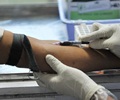
‘Microneedles are designed to puncture the outer layer of skin, which acts as a protective shield, but not the next layers of epidermis and the dermis, which house nerves, blood vessels and active immune cells.’
Tweet it Now
The new system consists of a small, thin patch that is pressed against a patient's arm during medical treatment and measures drugs in their bloodstream painlessly without drawing any blood. The tiny needle-like projection, less than half a milimetre long, resembles a hollow cone and does not pierce the skin like a standard hypodermic needle.
"Many groups are researching microneedle technology for painless vaccines and drug delivery," said researcher Sahan Ranamukhaarachchi, PhD student at University of British Columbia in Canada.
"Using them to painlessly monitor drugs is a newer idea," Ranamukhaarachchi, who developed this technology during a research exchange at Paul Scherrer Institute (PSI) in Switzerland, said.
The microneedle created by Ranamukhaarachchi and his colleagues was developed to monitor the antibiotic vancomycin, which is used to treat serious infections and is administered through an intravenous line.
Advertisement
The researchers discovered that they could use the fluid found just below the outer layer of skin, instead of blood, to monitor levels of vancomycin in the bloodstream.
Advertisement
This technique allowed researchers to quickly and easily determine the concentration of vancomycin.
Source-IANS










